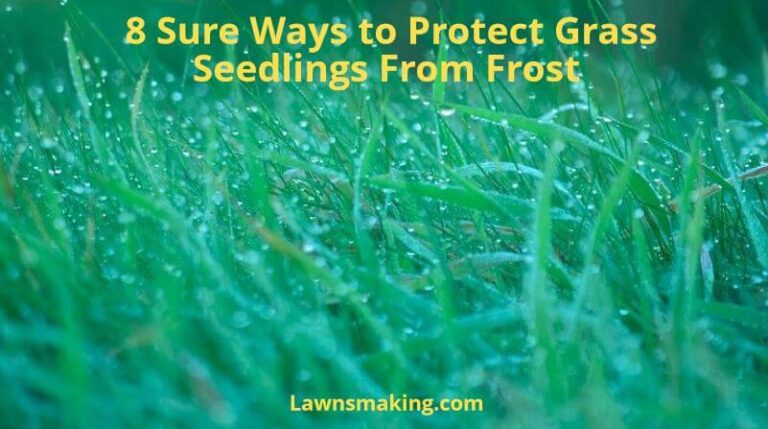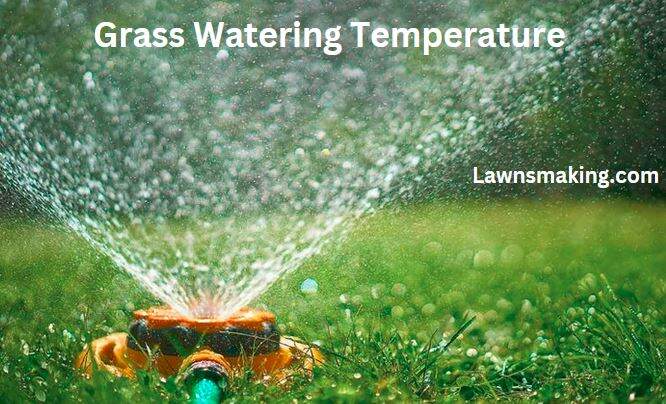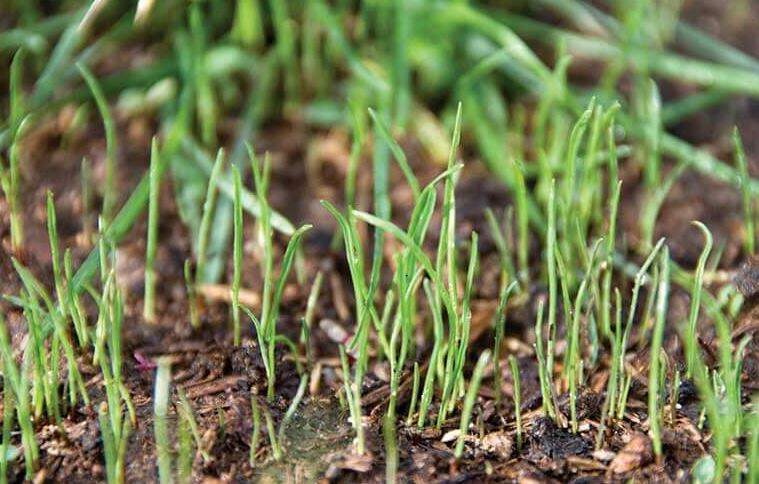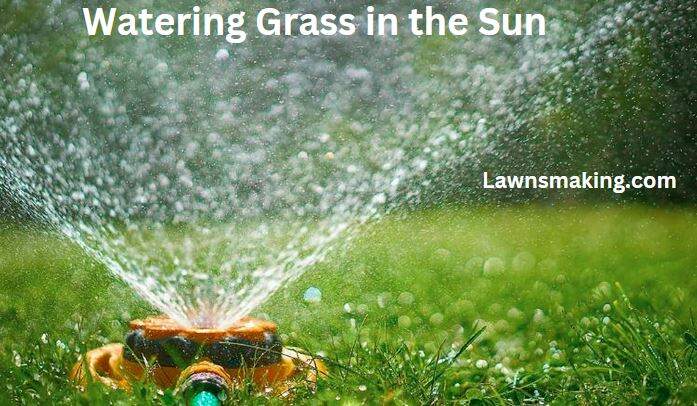
Incorrect fertilization timing results in environmental degradation—negatively impacting your grass’s growth and health. As such, you might wonder, “Should you fertilize before or after mowing?” especially if you want to avoid a spike in lawn maintenance costs.
A generally accepted rule of thumb is fertilizing your lawn a few days (3 – 5) after mowing, as this allows the grass to recover and absorb vital nutrients efficiently. You can opt for pre-mowing fertilization to enhance nutrient distribution and absorption thanks to zero grass blade interference.
In the rest of this article, I’ll help you navigate the considerations to make when facing the Mowing-Fertilizing Dilemma: Which Comes First? Moreover, you’ll learn about mowing and fertilization timing for the best results. Keep reading!
Lawn Mowing and Fertilizing Timing
Like most gardening enthusiasts, you might inquire about lawn mowing and fertilizer timing, especially if you’re emotionally connected to your outdoor space.
There are ways of mitigating inefficient nutrient and resource utilization from lawn care timing uncertainty.
Timing dictates everything in lawn care, from the health to the appearance of your turf. Consequently, proper mowing and fertilization timing ensures optimal grass growth and appearance.
Find Out: When Not to Apply Lawn Fertilizer
The Best Time to Mow Your Lawn
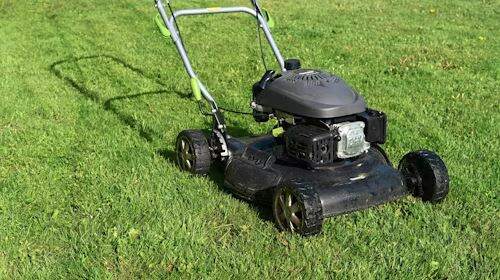
We all want our lawns to experience uniform growth without patches of overgrown or sparse areas. Luckily, one way to achieve that is by mowing at the right time.
That said, what is the best time to mow your lawn for the best results? If you’re in this dilemma, here are the key considerations to make when determining the best time to mow your lawn for the best results:
Grass Growth Rate
Different grass species exhibit different growth rates. Consequently, your lawn’s growth rate will influence your mowing schedule as follows:
- Cool-Season Grasses: Popular varieties include; ryegrass, fescue, and Kentucky bluegrass. These grass species experience fast growth rates in cooler months, especially spring and fall. As such, you may need to increase the mowing frequency in peak growing seasons.
- Warm-Season Grasses: Top examples include; St. Augustine, Zoysia, and Bermuda. These grass species experience accelerated growth rates in warm summer months. Consequently, warm-season grasses need regular mowing in warm summers.
Find Out: What Temperature Is Too Cold to Fertilize Lawn Areas?
Weather Conditions
Mowing in dry weather helps mitigate clumping and provides a cleaner cut. You should expect dry weather in specific months or seasons, depending on your jurisdiction. Generally, dry weather coincides with:
- Summer Months: Scheduling your mowing sessions during dry spells is vital in achieving optimal lawn care results. In many regions, summer months tend to be dry with minimal precipitation.
- Late Afternoons & Early Mornings: Humidity levels are lowest in the late afternoons and early mornings. Mowing during these openings results in quick drying times, minimal clumping, and even cuts.
Time of Day
Avoid mowing during hot spells since this will stress you and the grass. Instead, opt for morning or late afternoon mowing sessions. Here’s why these times are optimal for mowing:
- Early Morning Mowing: It will help to opt for early morning mowing sessions between 8 and 10 AM to take advantage of reduced temperature and humidity, which reduces stress on the grass. Moreover, morning mowing results in a clean cut, thanks to the lubrication of grass blades by morning dew.
- Late Afternoon Mowing: You can mitigate stress damage by mowing your lawn late in the afternoon to allow the grass to recover overnight. The best time for late afternoon mowing is anytime before sunset after 4 PM.
Mowing Frequency
Regular mowing encourages healthy grass growth and eases lawn management. However, mowing frequency depends on a variety of factors including; environmental conditions, grass species, growth rate, and more. Here are guidelines that will help you determine your mowing frequency:
- Cool-Season Grasses: These grass types require frequent mowing sessions during active growth periods in spring and fall. As such, aim to mow cool-season grasses every 7 to 10 days during peak growing seasons.
- Warm-Season Grasses: These grass varieties may exhibit stagnated growth in cool weather or periods of slow growth. However, regular mowing in warm weather mitigates turf overgrowth.
Grass Height
Adjust the mowing height to suit your grass species. Also, remember never to mow more than one-third of a grass blade’s length. Here’s how you can determine the ideal mowing height for common grass types:
- Cool-Season Grasses: Avoid cutting cool-season grasses like fescue and Kentucky bluegrass too short. Taller grass blades are essential in shading the soil and enhancing moisture retention. Therefore, set your mower height to 2.5 to 3.5 inches for cool-season grasses.
- Warm-Season Grasses: For improved weed suppression and lush dense growth, ensure warm-season grasses like Bermuda and Zoysia enjoy short mowing heights. As such, set your mower height to 1.5 to 2.5 inches for warm-season grasses.
When to Fertilize Your Lawn
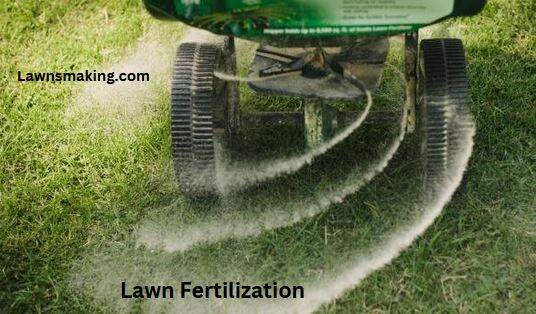
Gardeners, landscapers, and homeowners who make informed fertilizer timing decisions excel at growing and maintaining healthy lawns. Moreover, proper fertilization timing promotes robust root systems and stress resistance, plus reduces weed infestation.
Here are essential factors to consider before lawn fertilization:
Grass Type
Choose a fertilizer that meets your grass species’ nutrient requirements. Different grass types have varying requirements when it comes to nutrients like Nitrogen, Phosphorus, and Potassium.
Conduct soil tests to determine your lawn’s nutrient deficiencies as this will guide your fertilizer selection process. Cool-season grasses like Kentucky bluegrass thrive in soil with Nitrogen, Phosphorus, and Potassium in the ratio of 3-1-2. In contrast, warm-season grasses like Bermuda and Zoysia may require higher Nitrogen content to support their growth during active growth seasons.
Seasonality
Time fertilizer application to coincide with active growth periods like fall and spring. Temperatures begin to rise with spring’s onset, which results in grass emerging from their dormancy. Consequently, fertilizer application that coincides with spring’s active growth periods facilitates vigorous growth.
Likewise, fertilizer application in the fall strengthens the grass roots, preparing your lawn for winter dormancy, and a healthy lawn in the following spring. By supplying nutrients when the grass is actively growing, you enhance robust root and shoot development while promoting overall plant health.
Soil Temperature
The ideal soil temperature for lawn fertilization is 55°F and 85°F (12°C to 29°C). These temperatures are conducive to root nutrient uptake.
Rainfall Forecast
Fertilization should occur a day or two before imminent downpours to enhance nutrient activation while mitigating fertilizer runoff.
Avoiding Stress Periods
Fertilizing during stress periods like drought and extreme heat should be avoided, as this can further stress the grass.
Summary Table 1: Lawn Mowing vs. Fertilizing Timing
Many gardeners and homeowners deeply connect to nature, as highlighted by their commitment to sustainable gardening practices. Here is a table you can use to compare mowing to fertilizing against different aspects as you level up your lawn care practices:
| Aspect | Mowing | Fertilizing |
| Timing | Regularly, based on the grass’ growth rate | Seasonally, during periods of active growth |
| Frequency | Typically, weekly or bi-weekly | 2-4 times per year, depending on grass type |
| Ideal Conditions | Dry grass, morning or late afternoon | Mild temperatures, with rain in the forecast |
| Benefits | Promotes healthy growth and appearance | Provides essential nutrients for vigorous growth |
| Risks | Stress if mowed too short or during heat | Risk of nutrient burn if over-applied |
| Environmental Impact | Minimal, if managed properly | Risk of runoff and pollution if not applied correctly |
Lawn Fertilization After Mowing
Trimming grass blades involves cutting leaf material containing essential minerals and vitamins. Mowing also stresses the turf, as it involves damaging leaf blades physically. Therefore, lawn fertilization after mowing is the ideal post-mowing nutrient depletion and stress remedy.
Moreover, fertilizer application after mowing is the best approach for enhancing growth and nutrient absorption since it helps with;
- Achieving optimal health
- Enhancing yield and productivity
- Improving aesthetic appeal
How Long After Mowing Should I Fertilize?
Generally, it’s recommended to wait at least 3 to 5 days after mowing before fertilizer application. The 72 to 120-hour period allows grass blades to recover from stress, improving nutrient uptake. However, climatic conditions or your lawn’s unique needs can affect the ideal wait time.
Grass type and fertilizer formulation can also affect post-mowing fertilizer timing. Fortunately, you can contact your local extension office or lawn care service providers for accurate fertilization timing information. The information from these professionals will help you achieve a lush lawn with enhanced pest and disease resistance.
Pros and Cons of Fertilizing After Mowing
The secret to enhancing the aesthetic appeal of your lawn, outdoor spaces, and landscapes is promoting healthy grass growth. Check out the Pros and Cons of fertilizing after mowing if you want to make informed decisions.
| Aspect | Pros | Cons |
| Efficient Nutrient Uptake | Nutrients are readily available to grass roots. | Grass may experience temporary stress after mowing. |
| Even Distribution | Fertilizer can be evenly distributed across the lawn surface. | Timing may be affected by weather conditions. |
| Reduced Risk of Runoff | Minimizes the risk of nutrient runoff. | Requires proper timing and coordination with the mowing schedule. |
| Improved Nutrient Utilization | Grass can efficiently absorb and utilize nutrients. | You may need to adjust the fertilizer application rate based on the grass growth rate. |
Best Practices for Fertilizing After Mowing
Achieving optimal fertilization results after mowing can be deeply satisfying, mainly if you invest time and effort in nurturing your green spaces. With the following best practices for fertilizing after mowing, nurturing lawn health and appearance will be within your wheelhouse:
- Wait for the Grass to Recover: Fertilizer application should take place at least 3-5 days after mowing to minimize stress on the grass
- Choose the Right Fertilizer: The ideal lawn fertilizer should have a nutrient ratio suitable for your soil type and grass species.
- Follow Application Guidelines: Adhere to manufacturer guidelines during fertilizer application for optimal results.
- Water Appropriately: Light watering after fertilization activates the nutrients while preventing stress-related burns.
- Monitor Lawn Health: Keeping an eye on your lawn’s response to fertilization is vital, as it allows you to adjust the lawncare routine to maintain optimum health, growth, and appearance.
Lawn Fertilization Before Mowing
Past failures like over-fertilizing, under-fertilizing, and incorrect fertilizer timing should be a cue to explore alternative fertilizer timing options. For instance, it will help to opt for lawn fertilization before mowing, especially if post-mowing fertilizer application isn’t yielding the desired results.
Proceeding cautiously and following the best (pre-mowing fertilization) practices is vital in achieving optimal lawn health.
How Long After Fertilization Should I Mow?
Generally, waiting a few (2-3) days after fertilization before mowing gives grass roots a chance to absorb vital minerals and nutrients. Please avoid mowing too soon after fertilizer application to mitigate fertilizer granule displacement, which reduces the effectiveness of the application.
Pre-mowing fertilizer timing also depends on prevailing weather conditions, grass (species and growth rate), designated fertilizer, and more. The good news is you can guarantee optimal nutrient uptake, minimize environmental impact, and reduce the risk of fertilizer-related burns, thanks to the availability of professional insights and information from extension offices, landscaping experts, and local nurseries.
The Pros and Cons of Fertilizing Before Mowing
Are you among the many gardeners passionate about their craft? If so, it is safe to guess you strongly desire to improve your gardening skills and knowledge. Explore the pros and cons of pre-mowing fertilization to level up lawncare practices!
| Aspect | Pros | Cons |
| Nutrient Absorption | Grass roots can absorb nutrients more efficiently | Risk of removing fertilizer granules during mowing |
| Enhanced Fertilizer Uptake | Fertilizer is applied to the soil surface, allowing for better incorporation | Potential for uneven distribution if not spread evenly |
| Reduced Risk of Burn | Lower risk of fertilizer burns due to immediate watering | Requires careful timing to avoid mowing too soon |
| Improved Soil Penetration | Fertilizer can penetrate soil more effectively | The grass may appear greener initially but may lack sustained growth |
| Enhanced Weed Control | Fertilizer application can help suppress weed growth | Risk of environmental pollution if fertilizer runoff occurs |
Best Practices for Fertilizing Before Mowing
Learning about the best pre-mowing fertilization practices provides actionable lawn care insights. Besides using valuable insights, you can also share them with your online gardening communities, local clubs, and neighborhood associations to address environmental concerns or promote sustainable gardening practices.
Top pre-mowing fertilization practices include:
- Choose the Right Fertilizer: It will help to choose a fertilizer with a nutrient ratio suitable for your grass species and soil type
- Apply Evenly: Ensure uniform and even fertilizer distribution across your lawn using a calibrated spreader
- Water Immediately: A light watering session after fertilization is crucial in activating nutrients and mitigating burning.
- Time Mowing Appropriately: Wait 48 to 72 hours after fertilizing before mowing to facilitate optimal nutrient absorption.
- Monitor Effectiveness: Please observe your lawn’s response to fertilization to adjust your lawncare routine to maintain healthy growth and appearance.
Can I Mow and Fertilize on the Same Day?
You can mow and fertilize on the same day, but it is generally not recommended. Staggering mowing and fertilizing tasks maximize the effectiveness of the activities—facilitating optimal lawn health and growth. Staggering also improves nutrient uptake and alleviates stress.
One of the questions that would be on my mind as a homeowner who views their property as a long-term investment is, “Can I Mow and Fertilize on the Same Day?” especially if the property is about to hit the market.
A well-maintained and healthy lawn enhances a property’s value and attractiveness to potential buyers or neighbors. So, here are guidelines to follow if you are interested in mowing and fertilizing on the same day;
- Mow First: Mowing before fertilization ensures optimal contact between fertilizer (granules) and the soil—ensuring even coverage.
- Fertilize Carefully: Use a calibrated spreader to guarantee even fertilizer application, ensuring not to miss or overlap lawn areas.
- Water Lightly: A light watering session after fertilizing helps with nutrient activation and prevents burns.
- Avoid heavy traffic: Minimize foot traffic and activities on the lawn after fertilizing to ensure proper nutrient absorption and mitigate lawn damage.
- Monitor the lawn: Inspect your lawn’s response to fertilization, allowing you to tweak your lawncare routine as needed.
Can I Mow Directly After Fertilization?
Mowing directly after fertilization is generally not advisable since it can disrupt fertilizer (granule) distribution—lowering their effectiveness. Freshly cut grass blades may also be more susceptible to stress when in contact with fertilizer—increasing the risk of nutrient burn.
Your desire for a beautiful and perfect lawn might result from your emotional connection to your outdoor space. As such, you might ask questions like, “Can I Mow Directly After Fertilization?”
If you need to mow shortly after fertilization, please wait for at least one to two days for proper nutrient absorption by the grass roots, as this mitigates the unwanted nutrient loss. Moreover, the 24 to 48-hour wait time allows proper nutrient penetration in the soil, ensuring the availability of nutrients for the grass to utilize.
Should You Fertilize Before or After Mowing? Final Thoughts
As you embark on a journey to create a thriving lawn befitting future gatherings and celebrations, it will be best to remember the decision of whether to fertilize before or after mowing depends on various factors such as grass type, soil condition, and personal preference. Additionally, each approach has its advantages and considerations.
Fertilizing before mowing can ensure better soil penetration and nutrient absorption while fertilizing after mowing allows for even distribution and reduced risk of nutrient burn. Consequently, you can enjoy a beautiful and vibrant outdoor space that enhances the beauty of your home, especially if you opt for a fertilization and mowing schedule that suits your lawn.


